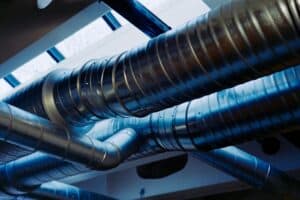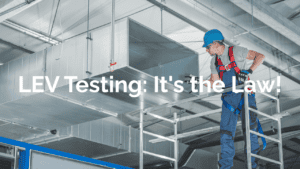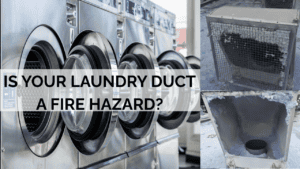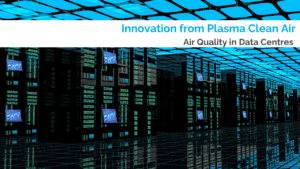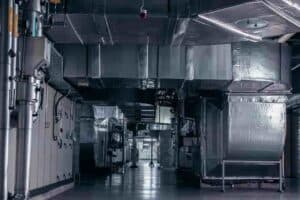By David J Glover PhD, Technical Director
Part 1: From Kitchens to Clean Air — Lessons Learned in the Field
This is the first of two articles based on a talk at a joint CIBSE and ASHRAE event on Developments in Indoor Air Quality for Health, Wellbeing and Productivity in Low Carbon and Net Zero Buildings.
This article (Part 1) covers the principles and technologies behind IAQ improvement based on a data- and experience-led look at how clean air systems are designed, measured, and implemented.
Part 2 will be published next week and focusses on turning clean air principles into lasting performance through maintenance, teamwork, and ongoing monitoring.
I was recently invited to speak at a joint CIBSE and ASHRAE event on Developments in Indoor Air Quality for Health, Wellbeing and Productivity in Low Carbon and Net Zero Buildings. This is the first of 2 articles based on my presentation.
When I submitted the title to my talk, it was Best Practice for UVC Air Cleaning in Occupied Healthcare Spaces — but the more I prepared, the more I realised that air cleaning technology is just one piece of a much larger picture.
Whether we’re talking about UVC, HEPA, electrostatic filters, or bipolar ionisation systems, the same principle applies: filters and devices are only effective when part of a well-understood, well-maintained system.
So, the title of my talk evolved into Best Practices for Clean Air in Occupied Spaces — based on our real-world experience at Plasma Clean Air, supporting clients to improve air and environmental quality across commercial buildings, healthcare, and hospitality.
From Kitchens to Clean Air
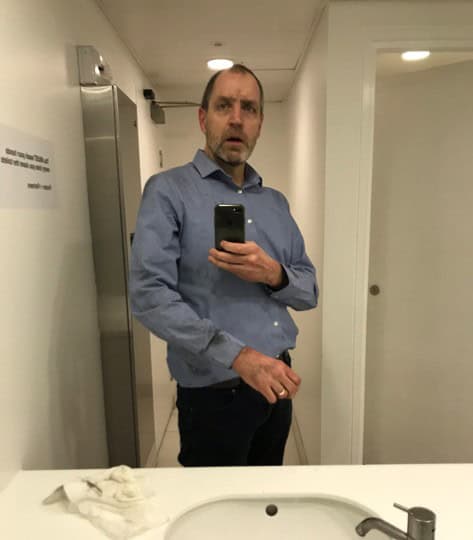
Plasma Clean Air began in commercial kitchen ventilation — tackling grease management and odour control in some of the toughest environments imaginable.
When I spun the company out of the University of Manchester in 2006, I didn’t appreciate quite how challenging grease-laden air would be. But those early lessons — around airflow, contamination, and maintenance — have proved invaluable for indoor air quality (IAQ) in supply air HVAC applications.
Even in supposedly “clean” supply air systems, contamination is common. During inspections, we often find dust contamination and microbial build-up inside air handling units and ductwork — even in premium commercial offices. What should be “fresh air” is often anything but. Check out the image of me below shortly after emerging from a supply air AHU.
Understanding the Environment
Every clean air project starts not with technology, but with understanding the environment — the system condition, space usage, and operational priorities.
When we approach a new project, we assess four key areas:
- Practicalities – condition of the ventilation system or room which needs treating
- Air Quality Monitoring – understanding the state of the environment through IAQ & IEQ monitoring as well as microbial sampling if required.
- Air Cleaning Technologies – choosing the best technology or combination of technologies to treat the space.
- Maintenance Mindset – ensuring that the systems continues to operate at design efficiency.
This requires a collaborative approach, bringing many disciplines together to deliver clean air whilst working towards Net Zero.
1. The Practicalities
It’s an obvious thing to say, but ventilation systems are designed around the building, not the other way around. Space, access, airflow volumes, and existing infrastructure can all dictate what equipment can or can’t be installed or retrofitted.
Regular inspection and cleaning are essential. In kitchens, we follow BESA TR19 Grease, and for supply air, TR19 Air. The BESA’s new ventilation hygiene guide for industrial and commercial sectors reinforces this, aligning with housing updates like Awaab’s Law, which mandates faster remediation of damp and mould.
Our approach is simple:
Clean first — then reduce cleaning frequency through effective filtration.
The same logic applies to supply air: move away from “fit and forget” to “inspect, maintain, and improve.”
Common Issues in Ventilation Systems
Several recurring issues undermine both IAQ and energy efficiency:
- Filter neglect: Panel and bag filters are often left clogged which dramatically increases the energy required to pull air through the ventilation system. When they become fully blocked, they are removed entirely, allowing airborne particles to move through the building.
- Coil contamination: Heat exchangers gather dust and biofilm, reducing both airflow and heat transfer efficiency.
- Air leakage: Galvanised ductwork leaks conditioned air, forcing fans to work harder and driving up energy use.
Leaky ductwork is like carrying water in a bucket full of holes — much of the air never reaches where it’s needed. That’s why it’s essential to begin with a thorough TR19 Air inspection and duct leakage test, followed by cleaning, filter replacement, and duct sealing to bring the system up to standard. Once restored, the system should be subject to annual audit inspections to ensure continued performance, energy efficiency and supporting the road to Net Zero.
Room Air Cleaners – Practical Considerations
When deploying room air cleaners, it’s important to consider the volume of the space, the number of air changes per hour in that space and the location of any mechanical ventilation.
Other practical design considerations include positioning of the air cleaners taking into account airflow paths, ceiling height and reflective surfaces (particularly for upper-room UV systems), as well as noise and thermal impact — all of which influence overall comfort and performance.
2. Air Quality Monitoring
You can’t fix what you don’t measure.
Since COVID, our approach has been simple: measure → analyse → implement. Before investing in technology or system upgrades, it’s vital to understand how the space actually performs in day-to-day operation.
Air quality monitoring provides that insight. It allows building operators to track CO₂ levels, temperature, humidity, and occupancy patterns — giving a real-time picture of ventilation performance, air change rates, and the potential for airborne infection transmission.
While elevated CO₂ levels don’t directly harm health, they serve as a reliable indicator of stale air, inadequate ventilation, and the likely build-up of other pollutants such as volatile organic compounds (VOCs), particulates and infection. Persistent high readings suggest that mechanical ventilation is either insufficient or underperforming.
Continuous monitoring helps identify:
- The effectiveness of ventilation systems under real operating conditions.
- Periods or areas of increased infection risk due to stagnant air.
- Environmental conditions that may encourage condensation, damp, or mould growth.
Modern sensors make this process far easier than it once was. Compact, connected devices now provide continuous data, visualised through dashboards that can alert operators to developing issues before they become major problems.
However, one ongoing challenge is cultural rather than technical. Many building owners and operators still view air quality monitoring as a risk — something that might expose hidden deficiencies and lead to costly remedial work. But without accurate data, any improvements are based on assumption rather than evidence.
The reality is that monitoring is not a cost — it’s an enabler of intelligent decision-making. It allows facilities teams to target interventions, verify performance, and demonstrate compliance with health, wellbeing, and sustainability standards.
In short, you can’t manage what you don’t measure, and ongoing monitoring is the foundation for any credible indoor air quality strategy.
3. Air Cleaning Technologies
Once the baseline conditions are understood through inspection and monitoring, the next step is to select and implement the right air cleaning solution. The choice depends on how the space is used, how air moves through it, and how easily the systems can be maintained.
In-duct technologies
For centralised or ducted systems, a range of in-duct air cleaning solutions can be integrated to enhance both air hygiene and energy performance:
- UVGI (Ultraviolet Germicidal Irradiation) — typically applied to heat exchange coils, UVGI prevents the growth of biofilms and maintains coil efficiency by keeping surfaces clean. This not only improves indoor air quality but also retains thermal transfer, reducing fan energy and improving system longevity.
- Bipolar Ionisation — this low-energy technology releases positive and negative ions into the airstream, which cluster airborne particles and microorganisms. This makes them easier to capture in filters.
- Advanced Filtration — upgrading filters from coarse grades (such as G4) to higher-efficiency media (F7–F9) improves particulate removal. When combined with electrostatic or ionisation systems, overall capture efficiency for ultrafine particles can be significantly increased without excessive pressure drop.
In-room technologies
For spaces without central air handling systems, or where supplementary treatment is needed, in-room systems can be highly effective:
- Upper-room UVGI systems create a disinfecting zone in the upper airspace, continuously inactivating airborne microorganisms which drift into upper room as the room air circulates.
- Portable or fixed air cleaners combine filtration, ionisation, or UVGI to provide localised clean air delivery, especially useful for high-occupancy or poorly ventilated areas.
- UV surface treatment systems are designed to disinfect exposed surfaces — ideal for healthcare and laboratory settings where surface contamination risk is high. These systems however cannot operate when occupied for obvious UVC safety considerations.
Each building requires a tailored combination of these technologies, guided by a practical understanding of airflow dynamics, occupancy levels, pollutant sources, and maintenance capability.
There is no single “best” solution. The most effective clean air strategies combine technologies to achieve measurable results — improving air hygiene, reducing infection risk, and supporting energy efficiency goals without overburdening the system or facilities team.
Conclusion
Achieving clean, healthy indoor air is a multi-layered process that begins with understanding the environment, measuring performance, and carefully selecting the right combination of technologies. From in-duct UVGI and advanced filtration to room-based air cleaners and upper-room UV systems, every intervention must be guided by data, practical considerations, and a focus on long-term effectiveness.
But even the best-designed system will underperform without consistent attention and care. That’s why next week, in Part 2 of this series, we’ll focus on the critical role of PPM – Planned Preventative Maintenance – in keeping ventilation and filtration systems operating at maximum efficiency, ensuring that clean air solutions deliver lasting performance, energy savings, and healthier spaces for everyone.
Find out more…
Plasma Clean Air partners with M&E consultants, contractors, and facilities teams to improve indoor air quality through a combination of cleaning, monitoring, filtration, and advanced disinfection technologies.
To learn more about our solutions for IAQ improvement, ventilation hygiene, and retrofit support, contact our technical team today.
